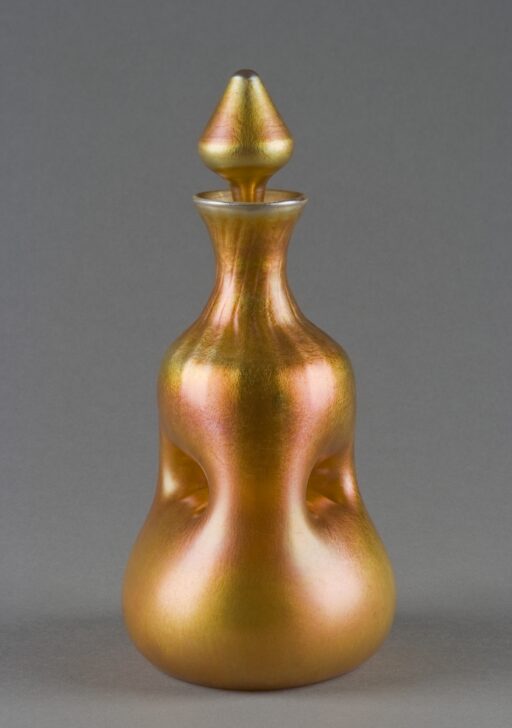Kuttrolf-like Decanter
Louis Comfort Tiffany

Description
March 28, 2009
Henry and Lousine Havemeyer were active collectors of the hand-made, iridescent glass made by Louis Comfort Tiffany. Though Tiffany had been known for making leaded glass windows since the late 1870s, he only began to make blown-glass vessels in the early 1890s—not long after he completed work on the Havemeyer house in New York. Tiffany’s term for this opulent glasswork was Favrile (a word derived from the Old English work fabrile, meaning “handmade”); Tiffany obtained a patent for the richly colored and iridescent Favrile glass in 1894.
Working with Tiffany to select outstanding pieces, the Havemeyers amassed an impressive collection of his Favrile glass; much of it was donated by the family to the Metropolitan Museum of Art in New York. Nearly all of the Tiffany glass in the University of Michigan’s collection was purchased at auction in 1930, along with the architectural fragments, by Emil Lorch.
Subject Matter:
Henry and Lousine Havemeyer were active collectors of the hand-made, iridescent glass made by Louis Comfort Tiffany. Tiffany had been known for making leaded windows since the late 1870s, but only began to make blown-glass vessels in the early 1890s—not long after his work on the Havemeyer house in New York. Tiffany’s term for this opulent glasswork was Favrile (a term derived from the Old English work fabrile, meaning “handmade”); Tiffany obtained a patent for the richly colored and iridescent
Favrile glass in 1894.
Working with Tiffany to select outstanding pieces, the Havemeyers amassed an impressive collection of Tiffany’s Favrile glass; much of it was donated by the family to the Metropolitan Museum of Art. Nearly all of the Tiffany glass in the University of Michigan’s collection was purchased at auction in 1930, along with the architectural fragments, by Emil Lorch, University of Michigan's Dean of the College of Architecture and Design.
Kuttrolf bottles and decanters were first introduced during the 14th century in northern Europe; such vessels had multiple-channel necks (often tilted at an angle) to facilitate a slow pouring of the liquor held in the containers.
Physical Description:
This orange/yellow iridescent decanter with a triangular-shapped stopper is pinched in the middle, dividing the vessel into several separate channels.
Usage Rights:
If you are interested in using an image for a publication, please visit https://umma.umich.edu/request-image/ for more information and to fill out the online Image Rights and Reproductions Request Form.